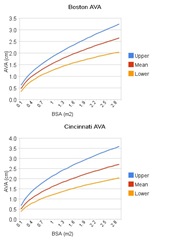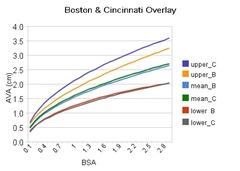The January 2008 issue of JASE includes the article:
Routine Adjustment of Doppler Echocardiographically Derived Aortic Valve Area Using a Previously Derived Equation to Account for the Effect of Pressure Recovery (source)
Wherein the matter of cath vs. echo discrepancies in evaluating aortic stenosis is addressed. While this article focuses on the matter of the aortic valve area, prior work has directed attention to the differences in gradients:
Comparison of simultaneous invasive and noninvasive measurements of pressure gradients in congenital aortic valve stenosis (source)
Combining the concepts of the two articles, this calculator considers both pressure recovered valve area and gradient estimations, as given by the formulae in the aforementioned articles:
Aortic Stenosis Valve Area and Pressure Recovery Calculator
(I originally busted this out back in January; it has been updated to run as a JavaScript calculator so as to be compatible here in it's new home on Blogger)
update, Nov. 2014:
The calculator on this site is broken :-| .
So I moved it: www.parameterz.com/tools/aortic-valve-area-and-pressure-recovery.



